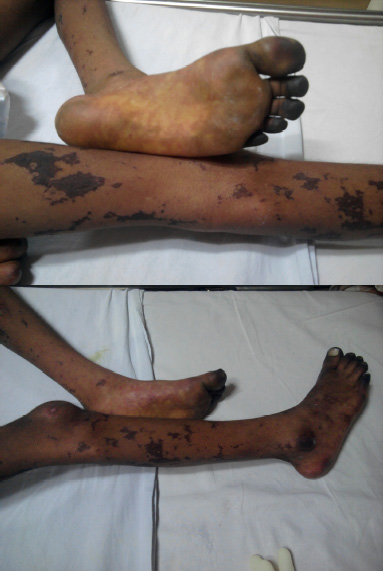Purpura Fulminans in a Child: A Case Report
Shrikiran Aroor1, Chaitanya Varma2, Suneel C Mundkur3
1 Professor, Department of Paediatrics, Kasturba Medical College, Manipal, Karnataka, India.
2 Assistant professor, Department of Paediatrics, Kasturba Medical College, Manipal, Karnataka, India.
3 Associate Professor, Department of Paediatrics, Kasturba Medical College, Manipal, Karnataka, India.
NAME, ADDRESS, E-MAIL ID OF THE CORRESPONDING AUTHOR: Dr. Chaitanya Varma, Assistant professor, Department of Paediatrics, Kasturba Medical College, Manipal, Karnataka, India.
Phone: +919964143170. Em-ail: pvc_varma@yahoo.com.
Purpura Fulminans is a life threatening condition characterised by cutaneous haemorrhage and gangrenous necrosis. We present such a case in an eight year old child.
Necrosis, Peripheral gangrene, Pseudomonas, Purpura Fulminans
INTRODUCTION
Purpura Fulminans (PF) is a life-threatening disorder of acute onset which is characterized by cutaneous haemorrhage. It was first described in 1884 by Guelliot. PF has a characteristic erythema with central areas of a blue-black haemorrhagic gangrenous necrosis which has a surrounding erythematous border. The necrosis may extend to the muscle and the bone, contributing to a late mortality and morbidity. Its healing leads to scarring, and auto-amputation of the digits [1]. Hypotension and Disseminated Intravascular Coagulation (DIC) may also be present.
Inherited and acquired abnormalities of the protein C and the protein S anticoagulant pathways are responsible for a majority of the cases of PF. The acute infectious variety is usually caused by gram-negative organisms.The idiopathic variety is uncommon and it mostly involves the skin [2]. The differential diagnosis includes thrombotic thrombocytopaenic purpura, Henoch–Schönlein purpura and post-infectious thrombocytopaenic purpura which differ by the degree of severity of the skin involvement. Herewith, we are reporting a case of Purpura fulminans which was considered to be of the acute infectious variety.
CASE REPORT
An 8 year old male child presented with a history of fever and a purpuric rash which involved all the 4 limbs and the trunk since the previous 18 days. The rash later developed into gangrene of all the digits and the pinna [Table/Fig-1]. A clinical diagnosis of Purpura fulminans was considered. The haemoglobin was 11g/dl, the total count was elevated (14,000/ml) and the platelet count was 6.8 lakhs/dl. The peripheral smear showed anisopoikilocytosis, polychromasia and a neutrophil count of 60%. The erthrocyte sedimentation rate was high (ESR=84mm/hr), the Prothrombin Time (PT)was 18 secs with a control of 15 secs and the International Normalized Ratio (INR) was 1.25. The routine urine test, the liver function tests, the renal function tests and the serum electrolytes were normal. The blood culture grew Pseudomonas. Due to financial constraints and the case having no clinical manifestations, the workup for other hyperocoaguble states were not done.
Diffuse purpuric rashes of the lower limbs with gangrene of the digits

DISCUSSION
Though the inherited and the acquired abnormalities of the protein C and the protein S anticoagulant pathways are responsible for a majority of the cases of PF, the present case was considered to be of the acute infectious variety, which was caused by Pseudomonas. The mortality rates of the infectious variety of PF and the idiopathic variety with secondary infection have decreased considerably, as a result of the treatment of the secondary infections, a better supportive care and the use of other therapies. The management involves supportive therapy, replacement of the blood products and the clotting factors and the use of the appropriate antibiotics [3]. The child was treated supportively with intravenous (i.v.) fluids and supportive ventilation. The child was also started on i.v. ceftazidime as per the blood culture sensitivity report, along with i.v. heparin in view of the peripheral gangrene. However, the child’s condition deteriorated progressively and he was discharged against medical advice in a moribund state.
[1]. Davis M DP, Dy KM, Nelson S, The presentation and the outcome of Purpura fulminans which was associated with peripheral gangrene in 12 patients at the Mayo ClinicAm Acad Dermatol. 2007 December 57(6):944-56. [Google Scholar]
[2]. Darmstadt GL, Acute infectious purpura fulminans: pathogenesis and medical managementPediatr Dermatol. 1998 15:169-83. [Google Scholar]
[3]. Talwar A, Kumar S, Gopal MG, Nandini AS, The spectrum of purpura fulminans: A report on the three classical prototypes and a review of the management strategiesIndian J Dermatol Venereol Leprol. 2012 Mar 78(2):228 [Google Scholar]